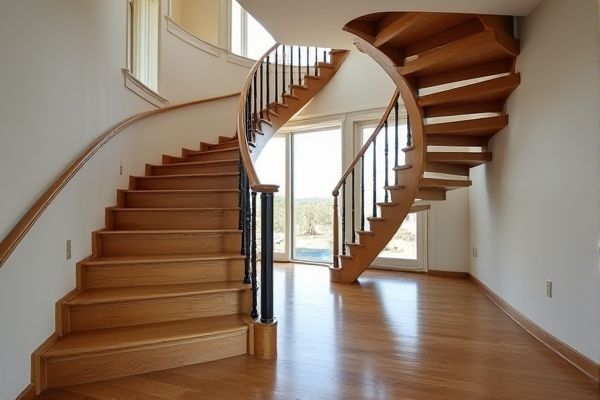
Curved staircases offer a graceful, sweeping design that provides both elegance and wider steps for safer use, while spiral staircases save space with their compact, circular structure but can be more challenging to navigate. Discover which staircase style best suits Your home's aesthetic and functional needs by reading the full comparison below.
Table of Comparison
| Feature | Curved Staircase | Spiral Staircase |
|---|---|---|
| Design | Graceful, wide sweeping curve | Compact, tight circular design |
| Space Efficiency | Requires more space | Highly space-saving |
| Installation Cost | Higher due to complexity | Generally lower and simpler |
| Safety | Safer with wider steps | Steeper, may be less safe |
| Aesthetic Appeal | Elegant, luxury style | Modern, minimalist look |
| Usage | Main staircases in large homes | Secondary access or tight spots |
| Customization | Highly customizable | Limited design variations |
| Material Options | Wood, metal, glass | Mostly metal and wood |
Introduction to Curved and Spiral Staircases
Curved staircases feature a smooth, continuous arc with a wider tread surface, enhancing both aesthetics and safety in architectural design. Spiral staircases consist of a central pole with steps radiating around it, offering compactness and space efficiency ideal for limited areas. Both designs blend form and function, catering to different spatial and stylistic requirements in residential and commercial environments.
Key Design Differences
Curved staircases feature a smooth, continuous arc with wider steps that provide a gradual and elegant ascent, often spanning a larger footprint for a grand architectural effect. Spiral staircases revolve tightly around a central pole, maximizing space efficiency with compact, triangular steps ideal for small areas. The choice between the two depends on spatial constraints and desired aesthetic, as curved staircases offer dramatic visual appeal while spiral stairs prioritize functionality in limited spaces.
Space Requirements and Placement
Curved staircases require more floor space than spiral staircases due to their wider and more gradual arc, making them suitable for larger interiors with ample room for elegant flow. Spiral staircases have a compact footprint, often fitting in tight corners or small areas, which is ideal for maximizing space in limited layouts. Placement of curved staircases typically emphasizes open, central locations as architectural features, whereas spiral staircases are frequently positioned against walls or within minimal spaces for functional access.
Aesthetic Appeal and Visual Impact
Curved staircases offer a sweeping, elegant design that enhances spacious interiors with smooth, flowing lines and can serve as a stunning architectural centerpiece. Spiral staircases provide a compact footprint with a dynamic, sculptural form that adds a striking visual element, especially in smaller spaces or modern settings. Both styles elevate aesthetic appeal, but curved staircases emphasize grandeur and fluidity while spiral staircases highlight functionality and artistic impact.
Construction Complexity and Cost
Curved staircases require intricate craftsmanship and custom-built components, resulting in higher construction complexity and increased costs compared to spiral staircases. Spiral staircases feature a more standardized, modular design that simplifies installation and reduces labor expenses. Material choices and space requirements further influence the overall budget, with curved stairs typically demanding premium materials and more extensive engineering.
Safety and Accessibility
Curved staircases offer enhanced safety due to their wider treads and consistent step depth, making them easier to navigate for individuals of all ages and abilities. Spiral staircases, often compact with narrower steps and a central support pole, can pose challenges for accessibility and increase the risk of slips or falls. Therefore, curved staircases are generally preferred in settings prioritizing safe and accessible design.
Material Options
Curved staircases offer diverse material options including wood, glass, metal, and stone, allowing for customization that suits traditional or modern interiors. Spiral staircases commonly utilize metal or wood due to their compact, structural design, often incorporating wrought iron or steel for durability and sleek aesthetics. Both designs can integrate glass panels or handrails to enhance visual appeal and light flow.
Functionality and Usability
Curved staircases offer enhanced functionality through wider steps and smoother transitions, making them ideal for high-traffic areas and safe, comfortable use. Spiral staircases maximize space efficiency in compact environments but can pose challenges in maneuverability and carrying larger items due to tighter turns and narrower treads. Choosing between these designs depends on balancing spatial constraints with ease of use and safety requirements.
Maintenance Considerations
Curved staircases require regular upkeep to protect their expansive handrails and open tread designs from dust and wear, often necessitating professional cleaning for polished finishes. Spiral staircases typically demand less maintenance due to their compact structure, but their narrow steps and tight corners can accumulate dirt in hard-to-reach areas, requiring detailed cleaning tools. Both styles benefit from periodic inspection of structural joints and handrails to ensure safety and longevity.
Choosing the Right Staircase for Your Space
Curved staircases create a grand, flowing aesthetic with wider steps and smoother transitions, ideal for spacious interiors where elegance and comfort are priorities. Spiral staircases save significant floor space with their compact, circular design, making them perfect for small or tight areas where functionality trumps grandeur. Your choice depends on balancing spatial constraints with design preference, ensuring your staircase complements the architecture and maximizes usability.
 homyna.com
homyna.com